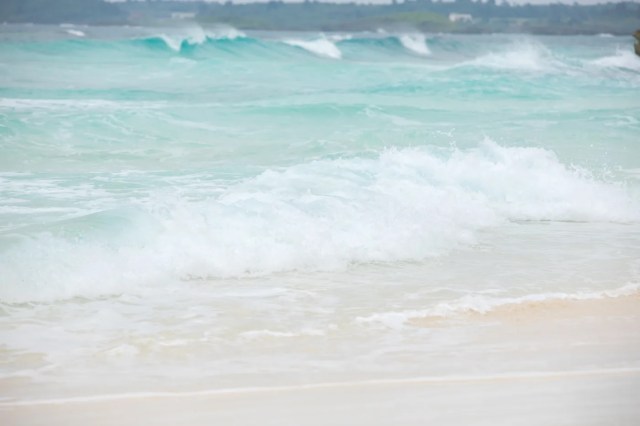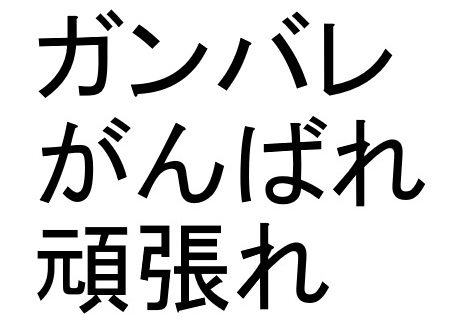
We need tissues, stat.
No one really likes having to be hospitalized, but if you do need extended medical care or observation, you could do a lot worse, in terms of ambiance, than Chiba Prefecture’s Kameda Medical Center. Located in the seaside town of Kamogawa, the hospital is just one block from the beach, and being able to see the ocean waves gently rolling against the sand from the building’s upper-floor windows likely has a soothing effect on the nerves of patients dealing with difficult medical conditions.
On a recent afternoon, though, it was more than just the natural scenery that was giving a boost to one patient’s spirits, as shown in these photos shared through the hospital’s official Twitter account.
今日はKタワー13階から誰かのママさんへのメッセージです! pic.twitter.com/SLEM7AV7zo
— 亀田総合病院(ちっとばあり公式) (@kmc_pr) November 24, 2021
Look closely at the pictures, taken from the 13th floor of the hospital, and you’ll see a row of driftwood, deliberately arranged in the following pattern:
The heart is pretty self-explanatory, but as for the rest of it, it’s katakana, a form of Japanese writing, and the message, “Mama, ganbare,” translates to
“Mama, hang in there!”
Apparently someone wanted to give their mom, who’s currently hospitalized at Kameda Medical Center, a special message, and rather than opt for a regular old get-well-soon card, decided to put their feelings into words on the beach. Adding an extra dash of poignancy is the fact that since January, as part of its coronavirus countermeasures, the hospital has stopped allowing ordinary patient visiting hours (with exceptions made for when visitation is deemed necessary), but whoever wrote the message still wanted to let Mom know that they were nearby, even if they couldn’t come into the building.
▼ Kameda Medical Center can be seen on the far right here.
The photos quickly had Twitter users tearing up, and not because of any sting from spraying saltwater.
“It’s so precious that they not only came up with the idea, but actually went ahead and did it to.”
“That’s gotta be heartwarming not just for the mom whose kid wrote the message, but for anyone at the hospital who sees it.”
“I’ll say it too: ‘Mama, hang in there!’”
“Hang in there, Mom! Your family is waiting for you.”
“Kameda Medical Center has an obstetrics ward, so maybe the message is for a mom-to-be.”
As mentioned above, the message is written in katakana, a type of Japanese script that’s usually used for writing foreign loanwords. It’s common for Japanese children to call their moms “Mama,” so katakana makes sense for that part, but why use it for ganbare, the part that’s an indigenous Japanese word? For starters, the simpler and more angular construction of katakana, as opposed to kanji and hiragana (the two types of script for indigenous Japanese words), makes it a lot easier to render when you’re using random pieces of driftwood instead of a pen.
▼ Ganbare, written, top to bottom, in katakana, hiragana, and mixed kanji/hiragana
Also, katakana, by nature of its sharper angles, tend to have a tough, bold visual impression, making it a great fit for ganbare here, since this is a message that’s both sweet and strong.
Source: Twitter/@kmc_pr, Kameda Medical Center via IT Media
Top image: Pakutaso
Insert images: SoraNews24
● Want to hear about SoraNews24’s latest articles as soon as they’re published? Follow us on Facebook and Twitter!



 Japan’s amazing healthcare system summed up in photo of hospital bill for father’s heart surgery
Japan’s amazing healthcare system summed up in photo of hospital bill for father’s heart surgery Japanese hospital threatens to stab owners of illegally parked cars with needles
Japanese hospital threatens to stab owners of illegally parked cars with needles Pokémon Center apologizes for writing model Nicole Fujita’s name as Nicole Fujita
Pokémon Center apologizes for writing model Nicole Fujita’s name as Nicole Fujita Japanese mom praises hard-studying teenage son…for his Pokémon notes?!?
Japanese mom praises hard-studying teenage son…for his Pokémon notes?!? Scandal as hospital staff take selfies, play games & hold parties while patients lie unconscious
Scandal as hospital staff take selfies, play games & hold parties while patients lie unconscious Japan’s new difficult-to-drink-from beer glass protects your liver, but it’s a brutal experience
Japan’s new difficult-to-drink-from beer glass protects your liver, but it’s a brutal experience Demon Slayer: Kimetsu no Yaiba gets new roller coaster attractions and food at Universal Studios Japan
Demon Slayer: Kimetsu no Yaiba gets new roller coaster attractions and food at Universal Studios Japan Come play hide-and-seek on a deserted Japanese island this August and November
Come play hide-and-seek on a deserted Japanese island this August and November Hello, cosmetics! Clinique teams up with Hello Kitty this summer for first-time collaboration
Hello, cosmetics! Clinique teams up with Hello Kitty this summer for first-time collaboration How to order snacks on a Shinkansen bullet train in Japan
How to order snacks on a Shinkansen bullet train in Japan New Pokémon ice cream, dessert drinks, and cool merch coming to Baskin-Robbins Japan【Pics】
New Pokémon ice cream, dessert drinks, and cool merch coming to Baskin-Robbins Japan【Pics】 New Nintendo Lego kit is a beautiful piece of moving pixel art of Mario and Yoshi【Photos】
New Nintendo Lego kit is a beautiful piece of moving pixel art of Mario and Yoshi【Photos】 McDonald’s adds a new Cheese Bacon Potato Pie to its menu in Japan for a limited time
McDonald’s adds a new Cheese Bacon Potato Pie to its menu in Japan for a limited time To combat declining birth rate, Japan to begin offering “Breeding Visas” to foreigners
To combat declining birth rate, Japan to begin offering “Breeding Visas” to foreigners Real Buddhist monk plays Super Mario Bros., recites prayers every time he kills an enemy【Video】
Real Buddhist monk plays Super Mario Bros., recites prayers every time he kills an enemy【Video】 Nintendo history you can feel – Super NES, N64, and GameCube controllers become capsule toys
Nintendo history you can feel – Super NES, N64, and GameCube controllers become capsule toys “The most Delicious Cup Noodle in history” – Japan’s French Cup Noodle wins our heart【Taste test】
“The most Delicious Cup Noodle in history” – Japan’s French Cup Noodle wins our heart【Taste test】 Starbucks releases a cute Frappuccino and Unicorn Cake…but not in Japan
Starbucks releases a cute Frappuccino and Unicorn Cake…but not in Japan Kyoto Tower mascot termination reveals dark side behind cute Japanese characters
Kyoto Tower mascot termination reveals dark side behind cute Japanese characters McDonald’s Japan’s Soft Twist Tower: A phantom ice cream only sold at select branches
McDonald’s Japan’s Soft Twist Tower: A phantom ice cream only sold at select branches Yabai Ramen: What makes this Japanese ramen so dangerous?
Yabai Ramen: What makes this Japanese ramen so dangerous? Finally! Nintendo Japan expands Switch 8-bit controller sales to everybody, Online member or not
Finally! Nintendo Japan expands Switch 8-bit controller sales to everybody, Online member or not Japanese government wants to build luxury resorts in all national parks for foreign tourists
Japanese government wants to build luxury resorts in all national parks for foreign tourists 10 things you should buy at 7-Eleven in Japan
10 things you should buy at 7-Eleven in Japan Studio Ghibli releases anime heroine cosplay dresses that are super comfy to wear
Studio Ghibli releases anime heroine cosplay dresses that are super comfy to wear Woman charged for driving suitcase without a license in Osaka
Woman charged for driving suitcase without a license in Osaka Studio Ghibli unveils My Neighbour Totoro miniature house model
Studio Ghibli unveils My Neighbour Totoro miniature house model Kyoto experiencing problems with foreign tourists not paying for bus fares, but not on purpose
Kyoto experiencing problems with foreign tourists not paying for bus fares, but not on purpose Fighting mild hunger with a Japanese soda that turns into jelly in the stomach【Taste test】
Fighting mild hunger with a Japanese soda that turns into jelly in the stomach【Taste test】 Studio Ghibli’s Howl’s Moving Castle tapestry unveiled in Japan for first time
Studio Ghibli’s Howl’s Moving Castle tapestry unveiled in Japan for first time McDonald’s new Happy Meals offer up cute and practical Sanrio lifestyle goods
McDonald’s new Happy Meals offer up cute and practical Sanrio lifestyle goods Sales of Japan’s most convenient train ticket/shopping payment cards suspended indefinitely
Sales of Japan’s most convenient train ticket/shopping payment cards suspended indefinitely Sold-out Studio Ghibli desktop humidifiers are back so Totoro can help you through the dry season
Sold-out Studio Ghibli desktop humidifiers are back so Totoro can help you through the dry season Japanese government to make first change to romanization spelling rules since the 1950s
Japanese government to make first change to romanization spelling rules since the 1950s Foreigner’s request for help in Tokyo makes us sad for the state of society
Foreigner’s request for help in Tokyo makes us sad for the state of society Ghibli founders Toshio Suzuki and Hayao Miyazaki contribute to Japanese whisky Totoro label design
Ghibli founders Toshio Suzuki and Hayao Miyazaki contribute to Japanese whisky Totoro label design Doraemon found buried at sea as scene from 1993 anime becomes real life【Photos】
Doraemon found buried at sea as scene from 1993 anime becomes real life【Photos】 Tokyo’s most famous Starbucks is closed
Tokyo’s most famous Starbucks is closed Princesses, fruits, and blacksmiths: Study reveals the 30 most unusual family names in Japan
Princesses, fruits, and blacksmiths: Study reveals the 30 most unusual family names in Japan How to get free healthcare in Japan without insurance
How to get free healthcare in Japan without insurance 6 surprising things about having a baby in Japan
6 surprising things about having a baby in Japan Kobe hospital gets anonymous 5 million yen cash donation, gives it back, gets it again, keeps it
Kobe hospital gets anonymous 5 million yen cash donation, gives it back, gets it again, keeps it How to make an ice cream sandwich…the Japanese way
How to make an ice cream sandwich…the Japanese way Now you can have churrasco style barbecue as rice cracker snacks!
Now you can have churrasco style barbecue as rice cracker snacks! Life saved in Tottori, Japan by same skin transplant treatment used for Kyoto Animation arsonist
Life saved in Tottori, Japan by same skin transplant treatment used for Kyoto Animation arsonist The delicious food of Japan’s gourmet hospitals: Ramen, hotpot, smoked duck, and more
The delicious food of Japan’s gourmet hospitals: Ramen, hotpot, smoked duck, and more “We wasted so much time in English class” — Japanese Twitter user points out major teaching flaw
“We wasted so much time in English class” — Japanese Twitter user points out major teaching flaw Search is on for COVID-19 patient who escaped out a sixth-floor window of Osaka hotel
Search is on for COVID-19 patient who escaped out a sixth-floor window of Osaka hotel Kobe hospital robbed of 6,000 surgical masks
Kobe hospital robbed of 6,000 surgical masks Four-time boxing champion Koki Kameda will take on all comers, winner gets 10 million yen
Four-time boxing champion Koki Kameda will take on all comers, winner gets 10 million yen Twitter users say Japanese Prime Minister’s name is hiding in the kanji for Japan’s new era name
Twitter users say Japanese Prime Minister’s name is hiding in the kanji for Japan’s new era name Big win for tattoo artists: Japan’s Supreme Court rules medical licenses aren’t necessary
Big win for tattoo artists: Japan’s Supreme Court rules medical licenses aren’t necessary Doctor punches patient in the stomach after his third visit to ER in one night
Doctor punches patient in the stomach after his third visit to ER in one night New arrest warrant issued for Kyoto Animation arson suspect
New arrest warrant issued for Kyoto Animation arson suspect
Leave a Reply